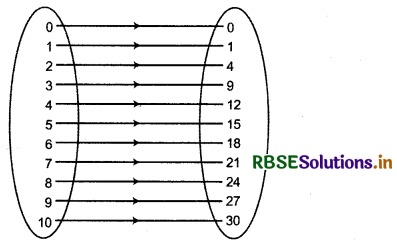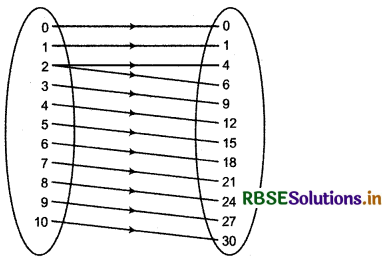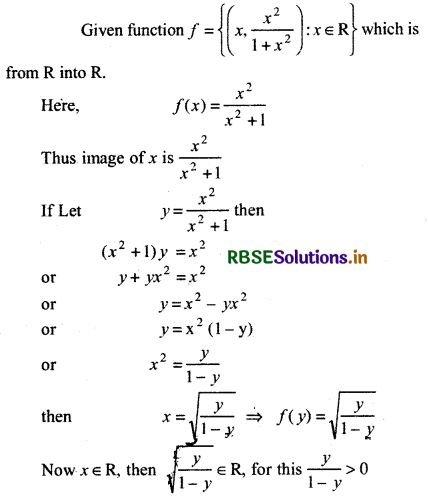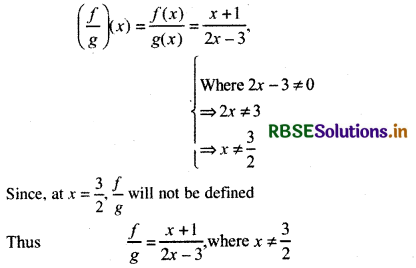RBSE Solutions for Class 11 Maths Chapter 2 Relations and Functions Miscellaneous Exercise
Rajasthan Board RBSE Solutions for Class 11 Maths Chapter 2 Relations and Functions Miscellaneous Exercise Textbook Exercise Questions and Answers.
Rajasthan Board RBSE Solutions for Class 11 Maths in Hindi Medium & English Medium are part of RBSE Solutions for Class 11. Students can also read RBSE Class 11 Maths Important Questions for exam preparation. Students can also go through RBSE Class 11 Maths Notes to understand and remember the concepts easily.
RBSE Class 11 Maths Solutions Chapter 2 Relations and Functions Miscellaneous Exercise
Question 1.
The relation f is defined by

The relation g is defined by

Show that f is a function and g is not a function.
Answer:
(i) Relation f is defined by

Domain of this relation = {0, 1, 2, 3, 4, 5, 6, 7, 8, 9, 10} or {x: x, 0 ≤ x ≤ 10}
Now, f(0) = 0, f(1) = 1,
f(2) = 4,
f(3) = 9,
f(4) = 12,
f(5) = 15,
f(6) = 18,
f(7) = 21,
f(8) = 24,
f(9) = 27,
f(10) = 30
Now, Co-domain of relation = {0, 1, 4, 9, 12, 15, 18, 21, 24, 27, 30}
We see that each element of domain of relation f has a unique image in co-domain. This f is a function.

Second Method: If we make ordered pair of domain and co-domain of relation then we get {(0, 0), (1,1), (2, 4), (3, 9), (4,12), (5,15), (6,18), (7, 21) (8, 24), (9, 27),(10, 30)}.
We see that first element of these ordered pairs are distinct. Thus, f will be function.

(ii) Again, For relation g

Domain of relation g = {0, 1, 2, 3, 4, 5, 6, 7, 8, 9, 10}

Now, from g(x) = x2
g(0) = 0, g(1) = 1, g(2) = 4
and from g(x) = 3x
g( 2) = 6, g(3) = 9, g(4) = 12, g(10) = 30
Here, we see that in domain of relation of element 2 have two images 4 and 6. So, relation is not a function.
Question 2.
If f(x) = x2, find \(\frac{f(1.1)-f(1)}{(1.1-1)}\).
Answer:
∵ f(x) = x2
then f(1.1) = (1.1)2 = 1.21
f(1) = 12 = 1
Thus, \(\frac{f(1.1)-f(1)}{(1.1-1)}=\frac{1.21-1}{0.1}=\frac{0.21}{0.10}\)
= 2.1
∴ Required value = 2.1
Question 3.
Find the domain of the function
f(x) = \(\frac{x^2+2 x+1}{x^2-8 x+12}\).
Answer:
f(x) = \(\frac{x^2+2 x+1}{x^2-8 x+12}\)
Here x2 - 8x + 12 = (x - 6) (x - 2)
If x = 6 or x = 2, then function f(x) is not defined at x = 6 and 2. Thus, domain of f will be set of all real number except x = 6, x = 2 i.e. domain of function will be R-{2, 6}.
or Domain = (x: x ∈ R and 2, 6 ∉ R}
Since function will not be defined forx = 2 and x = 6.
⇒ Domain = R - {2, 6}

Question 4.
Find the domain and the range of the real function f defined by f(x) = √(x - 1).
Answer:
f(x) =√(x - 1)
Here, f is real function and x ∈ R
If x is less than 1 function will not be real. Thus for x - 1 ≥ 0 or x ≥ 1 function is defined. Thus domain of function will be set of all real numbers equal to or greater then 1 i.e.
Domain = {x : x ∈ R, x ≥ 1}
∵ Domain = [1, ∞)
here value of functions x = 1 is 0.
Since, f(1) = √1 - 1 = 0
and for remaining values of x, value of f(x) will be real numbers greater then 0.
Thus, range of functions = {x : x ∈ R, x > 0}
or [0, ∞)
Question 5.
Find the domain and the range of the real function f defined by f(x) = |x - 1|.
Answer:
∵ f(x) = |x - 1| is real function and will be positive for each value of x.
Thus, domain of function = set of all real numbers set = R
or Domain of function = (- ∞, ∞)
Range of function will be set of all positive real numbers i.e. range of given function = {x: x ∈ R, x ≥ 0} or Range = [0, ∞)
Question 6.
Let f = \(\left\{\left(x, \frac{x^2}{1+x^2}\right): x \in \mathbf{R}\right\}\) be a function from R into R. Determine the range of f.
Answer:

and 1 - y > 0 ⇒ 1 > y .
Thus, to define function value of y should be greater than 0 but should be less than 1.
Thus, range = {x: x ∈ R, 0 ≤ x < 1}

Question 7.
Let f, g : R → R be defined, respectively by f(x) = x + 1, g(x) = 2x - 3. Find f + g, f - g and \(\frac{f}{g}\).
Answer:
f(x) = x + 1, g(x) = 2x - 3
then (f + g) (x) = f(x) + g(x)
= x + 1 + 2x - 3
Thus (f + g) (x) = 3x - 2
or (f + g) = 3x - 2
Now (f - g) (x) = f(x) - g(x)
= (x + 1) - (2x - 3)
= x + 1 2x + 3
= 4 - x
or (f - g) = 4 - x

Question 8.
Let f = {(1 ,1), (2, 3), (0, -1), (-1, -3)} be a function from z to z defined by f(x) = ax + b, for some integers a, b. Determine a, b.
Answer:
f = {(1, 1), (2, 3), (0, -1), (-1, -3)} from Z to Z and f(x) = ax + b,
Now (1, 1), (0, - 1) ∈ f
Thus, f(1) = a × 1 + b = 1 → a + b = 1 ........... (1)
and f(0) = a × 0 + b = - 1
⇒ 0 + b = - 1
or b = - 1
then f(1) = a + b = 1 [From equation (1)]
or a - 1 = 1 Putting {b = - 1}
⇒ a = 1 + 1 ⇒ a = 2
Thus, a = 2, b = - 1
Required value a = 2, b = - 1

Question 9.
Let R be a relation from N to N defined by R = {(a, b): a, b ∈N and a = b2}. Are the following true?
(i) (a, a) ∈ R, for all a ∈ N
(ii) (a, b)∈ R implies (b, a) ∈ R
(iii) (a, b) ∈ R (h, c) ∈ R implies (a, c) ∈ R
Justify your answer in each case.
Answer:
R = {(a, b): a, b ∈ N and a = b2}
(i) (a, a) ∈ R, is not true since except 1, no number equal to square of itself i.e. 1 = 12 but 2 ≠ 22, 3 ≠ 32 and 4 ≠ 42 etc.
(ii) (a, b) ∈ R implies (b, a) ∈ R is not true. It is not true. Since,
4 = 22 but 2 ≠ 42
(a, b) ∈ R; (b, a) ∈ R is true when,
then (a, b) = (b, a)
Now, a = b2
Thus, (b2, b) = (b, b2)
or b2 = b
or b2 - b = 0
or b(b - 1) = 0
or b = 0 or b = 1
Since, 0 ∉ N
[0 is not a natural number]
Thus, if a = 1, then statement is true but not true for other natural numbers.
Thus, statement is not true for all natural numbers.
(iii) (a, b) ∈ R and (b, c) ∈ R implies a = b2 and b = c2.
Then a = (c2)2 = c4, √a = c2. Thus, (a, c) ∈ R is not true.
Thus given statement is not true.
Question 10.
Let A = {1, 2, 3, 4}, B = {1, 5, 9, 11, 15, 16} and f = {(1, 5), (2, 9), (3, 1), (4, 5), (2, 11)}. Are the following true?
(i) f is a relation from A to B.
(ii) f is a function from A to B.
Justify your answer in each case.
Answer:
(i) A = {1, 2, 3, 4}, B = {1, 5, 9, 11, 15, 16}
and f = {( 1,5), (2, 9), (3,1), (4,5),(2,11)}
Now,
A × B = {(1, 1), (1, 5), (1, 9), (1, 11), (1, 15), (1, 16), (2, 1), (2, 5), (2, 9), (2, 11), (2, 15), (2, 16), (3 ,1), (3, 5), (3, 9), (3, 11), (3, 15), (3, 16), (4, 1), (4, 5), (4, 9), (4, 11), (4, 15), (4, 16)}
We see that all elements of relation of occurs in A × B f is relation from A to B. Since f ⊂ A × B.
f is a function from A to B this is not true. Since, first element of ordered pair (2, 9) and (2, 11) are repeated.

Question 11.
Let f be the subset of Z × Z defined by f = {(ab, a + b):a, b ∈ Z}. Is f a function from Z to Z? Justify your answer.
Answer:
Given f = {(ab, a + b): a, b ∈ Z)
if a = 3 and b = 4, then ab = 3 × 4 = 12
and a + 6 = 3 + 4 = 7
Thus (12, 7) ∈ f
Again a = 12, b = 1 then ab = 12 × 1 = 12
and a + b = 12 + 1 = 13
Thus (12, 13) ∈ f
We see that for of for element 12 of domain two images v and 13 are obtained. Thus relation from z to z is not a function.
Question 12.
Let A = {9, 10, 11, 12, 13} and let f:A → N, be defined by f(n) = the highest prime factor of n. Find the range of f.
Answer:
A = {9, 10, 11, 12, 13} and f: A → N. f(n) = n
f = {(n, f(n), n is highest prime factor of n
Now, 9 = 3 × 3, 10 = 2 × 5, 11 = 11 × 1,
12 = 2 × 2 × 3, 13 = 13 × 1
n = 9, f(9) = 3. n = 10, f(10) = 5
n = 11, f(11) = 11, n = 12, f(12) = 3,
n = 13, f(13) = 13
Since, highest prime factor for 9, 3, 5 for 10, 11 for 11, 3 for 12 and 13 for 13.
Thus, Range of f = {3, 5.11, 3, 13}
or Range = {3.5, 11, 13}

- RBSE Solutions for Class 11 Maths Chapter 3 त्रिकोणमितीय फलन Ex 3.1
- RBSE Solutions for Class 11 Maths Chapter 2 संबंध एवं फलन विविध प्रश्नावली
- RBSE Solutions for Class 11 Maths Chapter 2 संबंध एवं फलन Ex 2.3
- RBSE Solutions for Class 11 Maths Chapter 2 संबंध एवं फलन Ex 2.2
- RBSE Solutions for Class 11 Maths Chapter 2 संबंध एवं फलन Ex 2.1
- RBSE Solutions for Class 11 Maths Chapter 1 समुच्चय विविध प्रश्नावली
- RBSE Solutions for Class 11 Maths Chapter 1 समुच्चय Ex 1.6
- RBSE Solutions for Class 11 Maths Chapter 1 समुच्चय Ex 1.5
- RBSE Solutions for Class 11 Maths Chapter 1 समुच्चय Ex 1.4
- RBSE Solutions for Class 11 Maths Chapter 1 समुच्चय Ex 1.3
- RBSE Solutions for Class 11 Maths Chapter 1 समुच्चय Ex 1.2